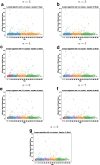Mutation-based clustering and classification analysis reveals distinctive age groups and age-related biomarkers for glioma
- PMID: 33639927
- PMCID: PMC7913451
- DOI: 10.1186/s12911-021-01420-1
Mutation-based clustering and classification analysis reveals distinctive age groups and age-related biomarkers for glioma
Abstract
Background: Malignant brain tumor diseases exhibit differences within molecular features depending on the patient's age.
Methods: In this work, we use gene mutation data from public resources to explore age specifics about glioma. We use both an explainable clustering as well as classification approach to find and interpret age-based differences in brain tumor diseases. We estimate age clusters and correlate age specific biomarkers.
Results: Age group classification shows known age specifics but also points out several genes which, so far, have not been associated with glioma classification.
Conclusions: We highlight mutated genes to be characteristic for certain age groups and suggest novel age-based biomarkers and targets.
Keywords: Age clusters; Glioma classification; IDH1; K-Means; Random Forest; XAI; explainable artificial intelligence; pediatric cancer.
Conflict of interest statement
The authors declare that they have no competing interests.
Figures














Similar articles
-
New insights into glioma classification based on isocitrate dehydrogenase 1 and 2 gene status.Brain Tumor Pathol. 2011 Jul;28(3):203-8. doi: 10.1007/s10014-011-0050-4. Epub 2011 Jul 7. Brain Tumor Pathol. 2011. PMID: 21735252 Review.
-
Isocitrate dehydrogenase 1 mutation subtypes at site 132 and their translational potential in glioma.CNS Oncol. 2018 Jan;7(1):41-50. doi: 10.2217/cns-2017-0019. Epub 2018 Jan 5. CNS Oncol. 2018. PMID: 29303363 Free PMC article.
-
Noninvasive IDH1 mutation estimation based on a quantitative radiomics approach for grade II glioma.Eur Radiol. 2017 Aug;27(8):3509-3522. doi: 10.1007/s00330-016-4653-3. Epub 2016 Dec 21. Eur Radiol. 2017. PMID: 28004160
-
IDH1/2 mutation status combined with Ki-67 labeling index defines distinct prognostic groups in glioma.Oncotarget. 2015 Oct 6;6(30):30232-8. doi: 10.18632/oncotarget.4920. Oncotarget. 2015. PMID: 26338964 Free PMC article.
-
Isocitrate dehydrogenase-mutant glioma: Evolving clinical and therapeutic implications.Cancer. 2017 Dec 1;123(23):4535-4546. doi: 10.1002/cncr.31039. Epub 2017 Oct 5. Cancer. 2017. PMID: 28980701 Review.
Cited by
-
Machine learning analysis of TCGA cancer data.PeerJ Comput Sci. 2021 Jul 12;7:e584. doi: 10.7717/peerj-cs.584. eCollection 2021. PeerJ Comput Sci. 2021. PMID: 34322589 Free PMC article.
-
Transcriptomic Landscape of Lower Grade Glioma Based on Age-Related Non-Silent Somatic Mutations.Curr Oncol. 2021 Jun 19;28(3):2281-2295. doi: 10.3390/curroncol28030210. Curr Oncol. 2021. PMID: 34205437 Free PMC article.
-
Molecular Determinants of Neurocognitive Deficits in Glioma: Based on 2021 WHO Classification.J Mol Neurosci. 2024 Feb 5;74(1):17. doi: 10.1007/s12031-023-02173-4. J Mol Neurosci. 2024. PMID: 38315329 Free PMC article.
-
A Risk Signature Consisting of Eight m6A Methylation Regulators Predicts the Prognosis of Glioma.Cell Mol Neurobiol. 2022 Nov;42(8):2733-2743. doi: 10.1007/s10571-021-01135-x. Epub 2021 Aug 25. Cell Mol Neurobiol. 2022. PMID: 34432221 Free PMC article.
-
An update on the molecular biology of glioblastoma, with clinical implications and progress in its treatment.Cancer Commun (Lond). 2022 Nov;42(11):1083-1111. doi: 10.1002/cac2.12361. Epub 2022 Sep 21. Cancer Commun (Lond). 2022. PMID: 36129048 Free PMC article. Review.
References
MeSH terms
Substances
LinkOut - more resources
Full Text Sources
Other Literature Sources
Miscellaneous

